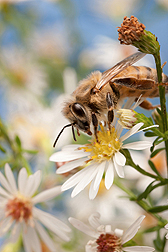from February 2015 issue of Agricultural Research magazine.
Honey Bee Diseases Strike in All Seasons
Agricultural Research Service scientists have found that two pathogens causing mysterious honey bee ailments are not just a problem in the spring, but might pose a threat year round. Entomologists Ryan Schwarz and Jay Evans at the ARS Bee Research Laboratory in Beltsville, Maryland, and their colleagues have shown that two species of bacteria, Spiroplasma melliferum and S. apis, are more common than thought and infect honey bees in places as diverse as Brazil and Maryland.
The two bacteria are often lumped together, since both are in the genus Spiroplasma, an intriguing class of bacteria found in some insects, ticks, and plants. S. melliferum was discovered in the late 1970s by ARS researchers who noticed higher mortality rates in bees carrying it. French researchers discovered S. apis a few years later and called it “May disease,” because that’s the month of year when it struck. It made bees “quiver and creep,” left some unable to fly, and in that instance, cut honey production by about 25 percent. Scientists, however, don’t know if S. melliferum and S. apis are factors in colony collapse disorder or other major bee mortalities, and they are unsure how lethal the bacteria are to bees.
 ARS scientists in Beltsville and their colleagues in Brazil screened honey bee colonies for two species of bacteria in the genus Spiroplasma and found high infection rates in both locations. (D3349-2) |
Schwarz, Evans, and their colleagues at the Brazilian Honey Bee Laboratory in São Paulo analyzed the DNA of bees they collected in Beltsville and Brazil at different times of the year between 2011 and 2013. Bees were collected from 11 states in Brazil and 2 areas in Beltsville. Schwarz had recently developed genetic markers that allow researchers to distinguish S. apis from other bacteria in bees. They used those markers and another recently developed set of S. melliferummarkers to determine the year-round prevalence of the two pathogens in both locations.
As expected, the researchers found that both pathogens were prevalent in the spring. But they also found that they were common at other times of the year and that prevalence rates varied depending on the location. In Beltsville, they were more prevalent in the spring, while in Brazil they were more prevalent in the fall. They also found high infection rates: 33 percent of the U.S. colonies and 54 percent of the Brazilian colonies were infected. The results also showed that S. melliferum was the more prevalent of the two and that the presence of one pathogen made bees more susceptible to the other. Schwarz says the different genetics and prevalence patterns show that the two pathogens should not be lumped together.
Certain plants can act as bacteria-transmission sites, and bees pick up the pathogens when they feed on plant nectar, Schwarz says. The results add to what is known about microbe transmission between plants and pollinators and should help beekeepers and scientists monitor the health of honey bees by raising awareness about the year-round nature of any threat the pathogens may pose. With the new genetic markers now available, scientists will also be better equipped to screen bee colonies for them.—By Dennis O'Brien, Agricultural Research Service Information Staff.
This research is part of ARS National Program #305, Crop Production.
"Honey Bee Diseases Strike in All Seasons" was published in the February 2015 issue of Agricultural Research magazine.

1 comment:
Thanks for a grreat read
Post a Comment